For my blog post I thought it would be useful to include notes on my favorite workshop from #FFDC2014, ‘Facilitation for Strategy Retreats’ led by Alli Welton from Divest Harvard and Jenny Marieneu of 350.org.
Great organizing starts with well thought through strategy, In our commitment to raise the scale of the climate crisis, occasionally we need to make sure our work is moving us closer towards our goals, and to determine whether our goals are true to what needs to be done. Strategy retreats are one way to take these questions head-on. Strategy retreats are one way to tackle these questions head-on.
The following blog post is a fusion of a reflection on the workshop itself, and the actual format used by Divest Dalhousie when we conducted our own strategy retreat in May 2014, just following the #FFDC2014.
Possible Timeline (approx 5 – 6 hours):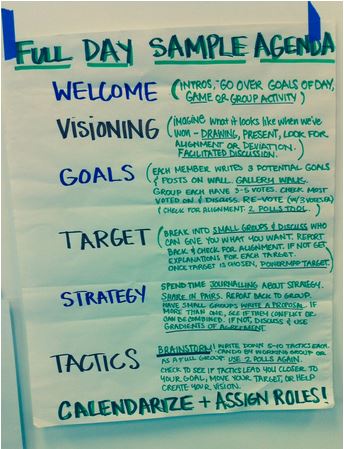
Welcome (20 min)
Visioning (30 min)
Goals (40 min)
LUNCH BREAK (30 min)
Target (45 min)
Strategy (45 min)
SNACK BREAK (15 min)
Tactics (45 min)
Calendar & Roles (30 min)
Break
Check out (30 min)
** To build a group container, we had about 6 facilitators who worked in pairs to deliver the above sections.
WELCOME (20 min)
- Acknowledging unceded Mi’kmaq territory
- Go around: name, gender pronouns, what you’d like to see the strategy session achieve and your noise / movement for the day (ice breaker).
- Switching seats
- Explain the reasons for a strategy session:
Why the heck are we doing this strategy retreat anyways?
There are ways to achieve your campaign goals that are not rooted in your vision, so if you are planning your campaign without a vision in mind, you may be working against yourself.
For example, if your vision includes a large, trained and disciplined youth resistance to climate change, you might achieve your goals for campus divestment with a few quick meetings with your administration and a committee, but you would end the campaign no closer to your vision than when you started.
For this reason, strategic planning is best done with visioning at the forefront. Think of it as starting with the big picture, and zooming in:
Begin with your vision, then determine your goal(s), then decide the best target. From there you can consider your strategy — how you adjust the balance of power between you and your target, and then determine your tactics. The end result looks a lot different than if you had just begun with tactics for divestment.
- Facilitator: summarize goals of the day / go over the agenda
- Brainstorm: campaign success moments
*change seats!*
& Yoga by Liv
** strategy retreats can be long, and include a lot of sitting, so including seat changes and exercise can help keep people energized!
VISIONING (30 min)
Drawing: *Imagine what it looks like when we’ve won*
Using a wall of chart paper, everyone takes about 15 minutes to use pictures and words to assert their vision on how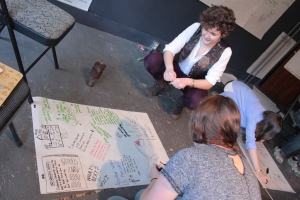 the world will look 10 years from now when we’ve won.
the world will look 10 years from now when we’ve won.
Facilitated discussion
Facilitator will lead a discussion where participants explain their vision. The facilitator will “prod” to bring forward alignments and deviations among the vision.
*change seats*
Yoga by Liv
GOALS (45 min)
 Gallery Walk – Each team member will have up to three sticky notes. They will write down a ‘Divest Dal’ campaign goal on each sticky and put it up on the wall. Once all the stickies are up on the wall, the facilitator will re-read the goals to the group, bring clarity to the goals, and to check for redundancy.
Gallery Walk – Each team member will have up to three sticky notes. They will write down a ‘Divest Dal’ campaign goal on each sticky and put it up on the wall. Once all the stickies are up on the wall, the facilitator will re-read the goals to the group, bring clarity to the goals, and to check for redundancy.
- 2 polls tool: Each member will have 3-5 check marks, that they can use to identify the goals that are most important to them. Once everyone has had a chance to vote, the facilitator will lead a discussion on what resulted. Each member of the group will have a chance to vote again. This time each member will have the chance to vote three more times (again votes can be pooled).Once the votes have been made, the facilitator will rank the goals, and check for alignment within the group.
***LUNCH TIME***
** we had a pot luck style lunch!
TARGET (45 min)
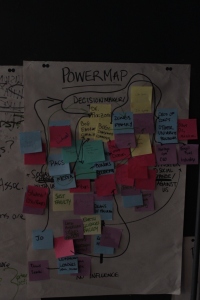 Power mapping* (thanks, MoveOn.org!): helps you determine theindividuals and groups in your community who are affected by the issue and who can influence your target.
Power mapping* (thanks, MoveOn.org!): helps you determine theindividuals and groups in your community who are affected by the issue and who can influence your target.
Before starting the power mapping activity: break into small groups and talk about who the ultimate “target” is in your campaign. After about 5-10 minutes of discussion, the facilitator will guide the report backs to the group, using gradients of agreement (thumbs up, abstain, thumbs down) to identify main target.
- Step 1: In small groups brainstorm all the individuals and groups in your community who are influential in your community and are directly impacted by the campaign issue. Think broadly of all the associations that have a relationship with the target. Be creative. Be strategic. Be thorough.
- Step 2: The grid.
Draw the following grid on chart paper: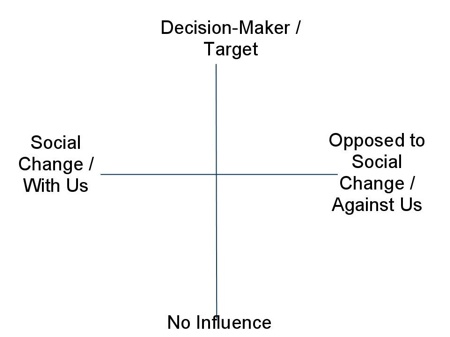
- Discuss among group who the main “target” is/are. Draw the target’s name at the top of the vertical line. Depending on where the target lands in terms of being “with us” or “against us,” write his or her name somewhere along the top—toward the left if he or she is “with us” and toward the right if he or she is “against us.” If you really aren’t sure, put the name in the middle.
- Step 3: Assess Influence
- Go back to your brainstorm list. For each organization and individual on the list, ask yourself: How much influence do they have? Are they with us or against us? Based on this assessment, place them in the appropriate place on the Grid. If you aren’t sure about your assessment or if members in your group disagree on how much influence a certain individual or group has, don’t spend more than a few minutes deliberating. If you can’t agree, just write that individual or group on the side of the grid and complete the research later.
- Step 4: Determine Connections:
- Take a step back and review the network you’ve created. Some of these people and institutions connect not only to your target–but also to each other. Start drawing lines to connect individuals and groups that have something in common. This will help you see connections between your Council and the target!
- Step 5: Determine Priority Relationships:
- Revisit your original list of community organizations and leaders. Draw circles around the individuals or groups you’ll want to prioritize your outreach to. Typically, you’ll want 5-10 top priorities–but you’ll probably want to reach out to nearly everyone on your list. Ideally, these individuals and groups represent the range of these criteria from your Power Map:
- Influential and likely helpful in pressuring the target. These groups are placed high up on the vertical axis,
- With us and likely to support our campaign. These groups are placed to the left on the horizontal axis.
- For the individuals and groups that are “with us,” consider how your Council can build relationships through your Council’s current connections and activities.
STRATEGY (45 min)
Reflection: everyone will spend about 15 writing about group strategy. This could be reflections on past strategy, the evolution of our strategy, but should really identify the individuals vision for the strategy moving forward. Check out this weird website if you want clarity on strategy vs tactics. In pairs, each person will take 5 min to share their notes. The facilitator will then lead a 15-20 min report back to the group.
- Write a proposal: In small groups, spend 10-15 min a proposal on strategy moving forward (point form). Report back to group once finished. The facilitator will lead a discussion to find alignments and disagreements, and to see if any proposals can be combined. Use gradients of alignment to determine which strategy proposal fits best for the group.
SNACKS #stormchips
Game: Graveyard or Camoflage
TACTICS (45 min)
Brainstorm!: As a large group, each person will write down 5-10 tactics (can be pictures or words) on large sheets of paper. The 2 polls system will be used to identify which tactics the group is most stoked on.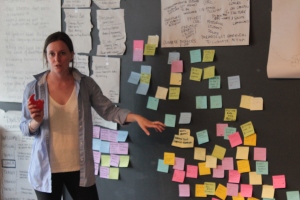
The facilitator will lead a discussion on the 5-10 most popular tactics, revisiting the power mapping chart to reflect on if the tactic will move us closer to the end goal, move our target, or achieve our vision.
Supplies:
– 2 large pieces of paper
– sticky notes
CALENDARIZE & ASSIGN ROLES (30 min)
** we had the following sections planned for the day, but since energy was low, we actually spent our next two weekly meetings finishing up these sections.
- The facilitator will lead a discussion to fill in tactics onto a calendar. Where necessary, tactics will be assigned with a “bottom liner”
- Strategy bank
- CALENDAR:
- By June 24 (BoG)
- By August 31
- For frosh week (August 31 – Sept 4)
- By Sept 31?
- By October Bo
Break
BIKE RACK
During the session, if any important discussions came up that weren’t necessarily pertinent to the strategy session, we put those on a ‘bike rack’ and over the course of several weeks, made sure that we gave time for these discussions in our regular meeting time.
CHECK OUTS (45 MIN)
- popcorn style point of reflection / learning moment.
- Timeline of successes
- #divestmentfamilyphoto

I would like to send a very warm thank-you to all of the people and groups who supported the delegation from Divest Dal to the #FFDC2014. I would especially like to thank DSUSO, NSPIRG, and the College of Sustainability.
